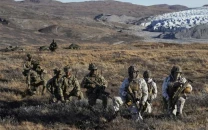Sick workers evacuated in daring South Pole rescue
The sick workers were transferred to a hospital in South America

Two sick workers were evacuated from a remote US research station near the South Pole on June 22, 2016 in a risky rescue mission carried out in the dead of Antarctica's winter. PHOTO: AFP
A Twin Otter turboprop plane flew in dark and cold conditions to pick up the workers from the Amundsen-Scott station, about 250 meters (820 feet) from the geographic South Pole, a spokesman for the US National Science Foundation (NSF), Peter West told AFP.
After a stop at a British station on the edge of Antarctica lasting several hours, another Twin Otter flew the two workers to Puntas Arenas, Chile's southernmost city, the NSF later said in a statement posted on its Facebook page.
US military, watchers rescue 3 men from deserted Pacific island
The plane landed around 9:40 pm on Wednesday.
The plane's crew and a medical team had made the 10-hour journey to the South Pole from the British Antarctic Survey's Rothera research station some 2,200 kilometers (about 1,365 miles) away in the middle of the continent's 24-hour winter on Tuesday night to reach the patients, who could not be treated on site.
The NSF, the US research agency that operates the Amundsen-Scott Station, organized the rescue mission last week given the condition of the first patient, which was not disclosed for privacy reasons.
"It was really an emergency," West said.
It later became apparent that the second worker also needed to be evacuated.
The sick workers, employees of the US company Lockheed Martin who worked on base logistics and were not identified, were then to be transferred to a hospital in South America, West said, without giving further details.
Woman rescued six days after Kenya building collapse
The Amundsen-Scott base was home to 48 people, 39 men and nine women, who work on-site throughout the austral winter, which spans February through October.
Near the world's southernmost point, workers spend this period withstanding nearly complete darkness and dramatically low temperatures, on Tuesday, the thermometer dropped to -60 degrees Celsius (-76 degrees Fahrenheit).
It was only the third time that an emergency rescue operation has been launched in the middle of winter.
In 2001, the only doctor at the Amundsen-Scott station was suffering from a life-threatening pancreatic condition and required urgent evacuation. A second medical evacuation was carried out that year.
In 1999, the US station's doctor Jerri Nielsen, who was self-treating her own breast cancer, required medical evacuation but weather conditions were more favorable, as the mission took place in the spring.
Combating Tragedies: Governor launches three rescue projects
The Twin Otter plane, operated by the Canadian company Kenn Borek Air, is specially designed to operate in extremely cold temperatures.
Research projects at the Amundsen-Scott station include monitoring long-term levels of carbon dioxide (CO2) in the atmosphere.
The station also operates two telescopes that observe "cosmic microwave background" radiation, the faint light signature left by the Big Bang, to study the origins of the universe, dark energy and dark matter.


















COMMENTS
Comments are moderated and generally will be posted if they are on-topic and not abusive.
For more information, please see our Comments FAQ